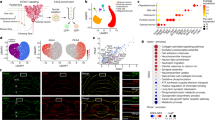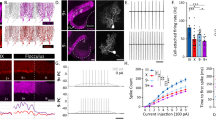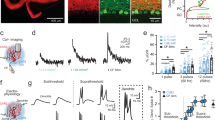Abstract
In mammals, identifying the contribution of specific neurons or networks to behavior is a key challenge. Here we describe an approach that facilitates this process by enabling the rapid modulation of synaptic inhibition in defined cell populations. Binding of zolpidem, a systemically active allosteric modulator that enhances the function of the GABAA receptor, requires a phenylalanine residue (Phe77) in the γ2 subunit. Mice in which this residue is changed to isoleucine are insensitive to zolpidem. By Cre recombinase–induced swapping of the γ2 subunit (that is, exchanging Ile77 for Phe77), zolpidem sensitivity can be restored to GABAA receptors in chosen cell types. We demonstrate the power of this method in the cerebellum, where zolpidem rapidly induces significant motor deficits when Purkinje cells are made uniquely sensitive to its action. This combined molecular and pharmacological technique has demonstrable advantages over targeted cell ablation and will be invaluable for investigating many neuronal circuits.
This is a preview of subscription content, access via your institution
Access options
Subscribe to this journal
Receive 12 print issues and online access
$209.00 per year
only $17.42 per issue
Buy this article
- Purchase on Springer Link
- Instant access to full article PDF
Prices may be subject to local taxes which are calculated during checkout





Similar content being viewed by others
References
Riedel, G. et al. Reversible neural inactivation reveals hippocampal participation in several memory processes. Nat. Neurosci. 2, 898–905 (1999).
Lomber, S.G. The advantages and limitations of permanent or reversible deactivation techniques in the assessment of neural function. J. Neurosci. Methods 86, 109–117 (1999).
Pereira de Vasconcelos, A. et al. Reversible inactivation of the dorsal hippocampus by tetrodotoxin or lidocaine: a comparative study on cerebral functional activity and motor coordination in the rat. Neuroscience 141, 1649–1663 (2006).
Wulff, P. & Wisden, W. Dissecting neural circuitry by combining genetics and pharmacology. Trends Neurosci. 28, 44–50 (2005).
Crick, F. The impact of molecular biology on neuroscience. Phil. Trans. R. Soc. Lond. B 354, 2021–2025 (1999).
Rudolph, U. & Mohler, H. Analysis of GABAA receptor function and dissection of the pharmacology of benzodiazepines and general anesthetics through mouse genetics. Annu. Rev. Pharmacol. Toxicol. 44, 475–498 (2004).
Farrant, M. & Nusser, Z. Variations on an inhibitory theme: phasic and tonic activation of GABAA receptors. Nat. Rev. Neurosci. 6, 215–229 (2005).
Whiting, P.J. GABAA receptors: a viable target for novel anxiolytics? Curr. Opin. Pharmacol. 6, 24–29 (2006).
Perrais, D. & Ropert, N. Effect of zolpidem on miniature IPSCs and occupancy of postsynaptic GABAA receptors in central synapses. J. Neurosci. 19, 578–588 (1999).
Thomson, A.M., Bannister, A.P., Hughes, D.I. & Pawelzik, H. Differential sensitivity to Zolpidem of IPSPs activated by morphologically identified CA1 interneurons in slices of rat hippocampus. Eur. J. Neurosci. 12, 425–436 (2000).
Campo-Soria, C., Chang, Y. & Weiss, D.S. Mechanism of action of benzodiazepines on GABAA receptors. Br. J. Pharmacol. 148, 984–990 (2006).
Rudolph, U. et al. Benzodiazepine actions mediated by specific γ-aminobutyric acidA receptor subtypes. Nature 401, 796–800 (1999).
Crestani, F., Martin, J.R., Mohler, H. & Rudolph, U. Mechanism of action of the hypnotic zolpidem in vivo. Br. J. Pharmacol. 131, 1251–1254 (2000).
Crestani, F., Martin, J.R., Mohler, H. & Rudolph, U. Resolving differences in GABAA receptor mutant mouse studies. Nat. Neurosci. 3, 1059 (2000).
McKernan, R.M. et al. Sedative but not anxiolytic properties of benzodiazepines are mediated by the GABAA receptor α1 subtype. Nat. Neurosci. 3, 587–592 (2000).
Wisden, W., Laurie, D.J., Monyer, H. & Seeburg, P.H. The distribution of 13 GABAA receptor subunit mRNAs in the rat brain. I. Telencephalon, diencephalon, mesencephalon. J. Neurosci. 12, 1040–1062 (1992).
Duncan, G.E. et al. Distribution of [3H]zolpidem binding sites in relation to messenger RNA encoding the α1, β2 and γ2 subunits of GABAA receptors in rat brain. Neuroscience 64, 1113–1128 (1995).
Niddam, R., Dubois, A., Scatton, B., Arbilla, S. & Langer, S.Z. Autoradiographic localization of [3H]zolpidem binding sites in the rat CNS: comparison with the distribution of [3H]flunitrazepam binding sites. J. Neurochem. 49, 890–899 (1987).
Sancar, F., Ericksen, S.S., Kucken, A.M., Teissere, J.A. & Czajkowski, C. Structural determinants for high-affinity zolpidem binding to GABAA receptors. Mol. Pharmacol. 71, 38–46 (2007).
Buhr, A., Baur, R. & Sigel, E. Subtle changes in residue 77 of the γ subunit of α1β2γ2 GABAA receptors drastically alter the affinity for ligands of the benzodiazepine binding site. J. Biol. Chem. 272, 11799–11804 (1997).
Wingrove, P.B., Thompson, S.A., Wafford, K.A. & Whiting, P.J. Key amino acids in the γ subunit of the γ-aminobutyric acidA receptor that determine ligand binding and modulation at the benzodiazepine site. Mol. Pharmacol. 52, 874–881 (1997).
Cope, D.W. et al. Abolition of zolpidem sensitivity in mice with a point mutation in the GABAA receptor γ2 subunit. Neuropharmacology 47, 17–34 (2004).
Cope, D.W. et al. Loss of zolpidem efficacy in the hippocampus of mice with the GABAA receptor γ2 F77I point mutation. Eur. J. Neurosci. 21, 3002–3016 (2005).
Ogris, W. et al. Affinity of various benzodiazepine site ligands in mice with a point mutation in the GABAA receptor γ2 subunit. Biochem. Pharmacol. 68, 1621–1629 (2004).
Smeyne, R.J. et al. Local control of granule cell generation by cerebellar Purkinje cells. Mol. Cell. Neurosci. 6, 230–251 (1995).
Häusser, M. & Clark, B.A. Tonic synaptic inhibition modulates neuronal output pattern and spatiotemporal synaptic integration. Neuron 19, 665–678 (1997).
Mittmann, W., Koch, U. & Häusser, M. Feed-forward inhibition shapes the spike output of cerebellar Purkinje cells. J. Physiol. (Lond.) 563, 369–378 (2005).
Santamaria, F., Tripp, P.G. & Bower, J.M. Feed-forward inhibition controls the spread of granule cell-induced Purkinje cell activity in the cerebellar cortex. J. Neurophysiol. 97, 248–263 (2007).
Laurie, D.J., Seeburg, P.H. & Wisden, W. The distribution of 13 GABAA receptor subunit mRNAs in the rat brain. II. Olfactory bulb and cerebellum. J. Neurosci. 12, 1063–1076 (1992).
Fritschy, J.M., Panzanelli, P., Kralic, J.E., Vogt, K.E. & Sassoe-Pognetto, M. Differential dependence of axo-dendritic and axo-somatic GABAergic synapses on GABAA receptors containing the α1 subunit in Purkinje cells. J. Neurosci. 26, 3245–3255 (2006).
Gunther, U. et al. Benzodiazepine-insensitive mice generated by targeted disruption of the γ2 subunit gene of γ-aminobutyric acid type A receptors. Proc. Natl. Acad. Sci. USA 92, 7749–7753 (1995).
Schweizer, C. et al. The γ2 subunit of GABAA receptors is required for maintenance of receptors at mature synapses. Mol. Cell. Neurosci. 24, 442–450 (2003).
Barski, J.J., Dethleffsen, K. & Meyer, M. Cre recombinase expression in cerebellar Purkinje cells. Genesis 28, 93–98 (2000).
Kittler, J.T. et al. Analysis of GABAA receptor assembly in mammalian cell lines and hippocampal neurons using γ2 subunit green fluorescent protein chimeras. Mol. Cell. Neurosci. 16, 440–452 (2000).
Brickley, S.G., Revilla, V., Cull-Candy, S.G., Wisden, W. & Farrant, M. Adaptive regulation of neuronal excitability by a voltage-independent potassium conductance. Nature 409, 88–92 (2001).
Marder, E. & Goaillard, J.M. Variability, compensation and homeostasis in neuron and network function. Nat. Rev. Neurosci. 7, 563–574 (2006).
Lima, S.Q. & Miesenbock, G. Remote control of behavior through genetically targeted photostimulation of neurons. Cell 121, 141–152 (2005).
Zhang, F. et al. Multimodal fast optical interrogation of neural circuitry. Nature 446, 633–641 (2007).
Gosgnach, S. et al. V1 spinal neurons regulate the speed of vertebrate locomotor outputs. Nature 440, 215–219 (2006).
Tan, E.M. et al. Selective and quickly reversible inactivation of mammalian neurons in vivo using the Drosophila allatostatin receptor. Neuron 51, 157–170 (2006).
Karpova, A.Y., Tervo, D.G., Gray, N.W. & Svoboda, K. Rapid and reversible chemical inactivation of synaptic transmission in genetically targeted neurons. Neuron 48, 727–735 (2005).
Yamamoto, M. et al. Reversible suppression of glutamatergic neurotransmission of cerebellar granule cells in vivo by genetically manipulated expression of tetanus neurotoxin light chain. J. Neurosci. 23, 6759–6767 (2003).
Wall, M.J. & Usowicz, M.M. Development of action potential-dependent and independent spontaneous GABAA receptor-mediated currents in granule cells of postnatal rat cerebellum. Eur. J. Neurosci. 9, 533–548 (1997).
McCartney, M.R., Deeb, T.Z., Henderson, T.N. & Hales, T.G. Tonically active GABAA receptors in hippocampal pyramidal neurons exhibit constitutive GABA-independent gating. Mol. Pharmacol. 71, 539–548 (2007).
Benavides, J. et al. In vivo interaction of zolpidem with central benzodiazepine (BZD) binding sites (as labeled by [3H]Ro 15–1788) in the mouse brain. Preferential affinity of zolpidem for the omega 1 (BZD1) subtype. J. Pharmacol. Exp. Ther. 245, 1033–1041 (1988).
Leppa, E. et al. Agonistic effects of the β-carboline DMCM revealed in GABAA receptor γ2 subunit F77I point-mutated mice. Neuropharmacology 48, 469–478 (2005).
Lein, E.S. et al. Genome-wide atlas of gene expression in the adult mouse brain. Nature 445, 168–176 (2007).
Zezula, J., Fuchs, K. & Sieghart, W. Separation of α1, α2 and α3 subunits of the GABAA-benzodiazepine receptor complex by immunoaffinity chromatography. Brain Res. 563, 325–328 (1991).
Oertel, W.H., Schmechel, D.E., Mugnaini, E., Tappaz, M.L. & Kopin, I.J. Immunocytochemical localization of glutamate decarboxylase in rat cerebellum with a new antiserum. Neuroscience 6, 2715–2735 (1981).
Korpi, E.R. et al. Cerebellar granule-cell–specific GABAA receptors attenuate benzodiazepine-induced ataxia: evidence from α6-subunit-deficient mice. Eur. J. Neurosci. 11, 233–240 (1999).
Acknowledgements
We thank E. Sigel for pointing out the γ2I77 mutation; J. Oberdick for the L7 expression cassette; S.J. Moss for the γ2F77GFP plasmid; M. Meyer for the L7Cre line; R. Tomioka and E. Mugnaini for antibodies to EGFP and GAD, respectively; H. Monyer for discussion and support; F. Zimmermann for the transgene and stem cell injections; I. Preugschat-Gumprecht for help with mouse genotyping; D. Andersson, T. Karayannis and M. Capogna for contributing to initial electrophysiological recordings; and S. Brickley, M. Capogna, S.G. Cull-Candy, C. De Zeeuw, N. Franks, T. Klausberger and Z. Nusser for comments on the manuscript. This work was funded by the VolkswagenStiftung (grant I/78 554 to W.W., E.R.K., W.S. and P.S.), the Deutsche Forschungsgemeinschaft (grant WI 1951/2 to W.W. and P.W.), the UK Medical Research Council (grant G0501584 to W.W.), the J. Ernest Tait Estate (to W.W. and T.G.), a Heidelberg Young Investigator Award (to P.W.), the Academy of Finland (to E.R.K. and A.-M.L.), the Sigrid Juselius Foundation (to E.R.K. and E.L.), the Institute Pasteur-Fondazione Cenci Bolognetti (to M.R.), the Austrian Federal Government (W.S.), the Medical University Vienna (W.S.) and a Wellcome Trust Programme Grant (to M.F.).
Author information
Authors and Affiliations
Contributions
The original idea was conceived by W.S. and developed with P.S., W.W. and E.R.K. Experiments were designed by M.F., E.R.K., P.S., P.W., W.S. and W.W. Experiments were performed by M.F., T.G., A.-M.L., E.L., M.R., J.D.S., P.S., O.Y.V., P.W. and W.W. Behavioral data were analyzed by E.L., A.-M.L. and E.R.K. Electrophysiological data were analyzed by M.F. The manuscript was written by M.F., P.W. and W.W. All authors commented on and helped to revise the text.
Corresponding author
Ethics declarations
Competing interests
The authors declare no competing financial interests.
Supplementary information
Supplementary Fig. 1
Generation of γ2I77lox and L7γ2F77GFP mice. (PDF 3384 kb)
Supplementary Fig. 2
Confirmation of Purkinje cell–specific Cre activity in the L7Cre line using ROSA26 indicator mice. (PDF 8956 kb)
Supplementary Fig. 3
Expression of the γ2F77GFP subunit in cerebellar Purkinje cells of PC-γ2–swap mice. (PDF 1678 kb)
Supplementary Fig. 4
In slices from PC-γ2–swap mice, potentiation of GABAA receptor–mediated mIPSCs by zolpidem is restricted to Purkinje cells. (PDF 152 kb)
Rights and permissions
About this article
Cite this article
Wulff, P., Goetz, T., Leppä, E. et al. From synapse to behavior: rapid modulation of defined neuronal types with engineered GABAA receptors. Nat Neurosci 10, 923–929 (2007). https://doi.org/10.1038/nn1927
Received:
Accepted:
Published:
Issue Date:
DOI: https://doi.org/10.1038/nn1927
This article is cited by
-
5-HT recruits distinct neurocircuits to inhibit hunger-driven and non-hunger-driven feeding
Molecular Psychiatry (2021)
-
Paraventricular hypothalamus mediates diurnal rhythm of metabolism
Nature Communications (2020)
-
Cerebellar molecular layer interneurons are dispensable for cued and contextual fear conditioning
Scientific Reports (2020)
-
Metabolic and psychiatric effects of acyl coenzyme A binding protein (ACBP)/diazepam binding inhibitor (DBI)
Cell Death & Disease (2020)



